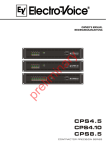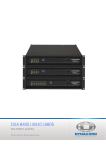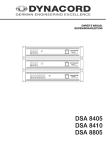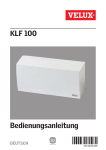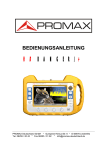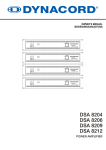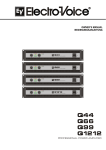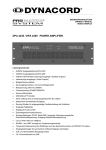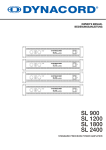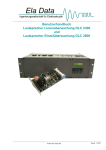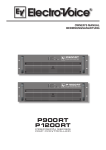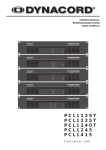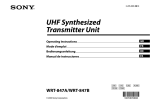Download DPA 8150 | 8225 | 8412
Transcript
DPA 8150 | 8225 | 8412 PROMATRIX 8000 POWER AMPLIFIER Owner‘s Manual | Bedienungsanleitung PROMATRIX 8000 Contents Inhalt INTRODUCTION . . . . . . . . . . . . . . . . . . . . . . . . . . . . . . 4 Power Amplifier . . . . . . . . . . . . . . . . . . . . . . . . 4 System Overview . . . . . . . . . . . . . . . . . . . . . . . 4 Scope Of Delivery And Warranty . . . . . . . . . . . 4 DEVICE DESCRIPTION & INSTALLATION . . . . . . . . . . . . . . 5 Front Panel . . . . . . . . . . . . . . . . . . . . . . . . . . . . 5 Rear Panel . . . . . . . . . . . . . . . . . . . . . . . . . . . . 6 Audio Inputs . . . . . . . . . . . . . . . . . . . . . . . . . . . 7 Audio Outputs . . . . . . . . . . . . . . . . . . . . . . . . . . 8 Integrated Relays . . . . . . . . . . . . . . . . . . . . . . . 9 CONTROL PORT . . . . . . . . . . . . . . . . . . . . . . . . 10 REMOTE CAN BUS . . . . . . . . . . . . . . . . . . . . . . 11 Supply Voltage . . . . . . . . . . . . . . . . . . . . . . . . . 12 Installation . . . . . . . . . . . . . . . . . . . . . . . . . . . . 12 OPERATION . . . . . . . . . . . . . . . . . . . . . . . . . . . . . . . . . 14 Ventilation . . . . . . . . . . . . . . . . . . . . . . . . . . . . . 14 Heat Development . . . . . . . . . . . . . . . . . . . . . . 14 Standby Operation . . . . . . . . . . . . . . . . . . . . . . 14 EOL . . . . . . . . . . . . . . . . . . . . . . . . . . . . . . . . . . 14 Fault Monitoring . . . . . . . . . . . . . . . . . . . . . . . . 15 Reset to Factory Settings . . . . . . . . . . . . . . . . . 16 Firmware Update . . . . . . . . . . . . . . . . . . . . . . . 16 SPECIFICATION . . . . . . . . . . . . . . . . . . . . . . . . . . . . . . 30 Block Diagram . . . . . . . . . . . . . . . . . . . . . . . . . . 34 Dimensions . . . . . . . . . . . . . . . . . . . . . . . . . . . . 35 EINFÜHRUNG . . . . . . . . . . . . . . . . . . . . . . . . . . . . . . . . Power Amplifier . . . . . . . . . . . . . . . . . . . . . . . . Systemübersicht . . . . . . . . . . . . . . . . . . . . . . . Lieferumfang und Garantie . . . . . . . . . . . . . . . GERÄTEBESCHREIBUNG & INSTALLATION . . . . . . . . . . . . Vorderseite . . . . . . . . . . . . . . . . . . . . . . . . . . . . Rückseite . . . . . . . . . . . . . . . . . . . . . . . . . . . . . Audioeingänge . . . . . . . . . . . . . . . . . . . . . . . . . Leistungsausgänge der Endstufe . . . . . . . . . . . Integrierte Relais . . . . . . . . . . . . . . . . . . . . . . . CONTROL PORT . . . . . . . . . . . . . . . . . . . . . . . . REMOTE CAN BUS . . . . . . . . . . . . . . . . . . . . . . Versorgungsspannung . . . . . . . . . . . . . . . . . . . Einbau . . . . . . . . . . . . . . . . . . . . . . . . . . . . . . . BETRIEB . . . . . . . . . . . . . . . . . . . . . . . . . . . . . . . . . . . Kühlung . . . . . . . . . . . . . . . . . . . . . . . . . . . . . . Wärmeentwicklung . . . . . . . . . . . . . . . . . . . . . . Standby-Betrieb . . . . . . . . . . . . . . . . . . . . . . . . EOL . . . . . . . . . . . . . . . . . . . . . . . . . . . . . . . . . Fehlerüberwachung . . . . . . . . . . . . . . . . . . . . . Rücksetzen auf Werkseinstellungen . . . . . . . . . Firmware Update . . . . . . . . . . . . . . . . . . . . . . . SPECIFICATION . . . . . . . . . . . . . . . . . . . . . . . . . . . . . . Block Diagram . . . . . . . . . . . . . . . . . . . . . . . . . Dimensions . . . . . . . . . . . . . . . . . . . . . . . . . . . . DPA 8000 - 2 18 18 18 18 19 19 20 21 22 23 24 25 26 26 27 27 27 27 27 28 29 29 30 34 35 DPA 8000 IMPORTANT SAFETY INSTRUCTIONS The lightning flash with arrowhead symbol, within an equilateral triangle is intended to alert the user to the presence of uninsulated „dangerous voltage“ within the product’s enclosure that may be of sufficent magnitude to constitute a risk of electric shock to persons. The exclamation point within an equilateral triangle is intended to alert the user to the presence of important operating and maintance (servicing) instructions in the literature accompanying the appliance. 1. 2. 3. 4. 5. 6. 7. 8. 9. 10. 11. 12. 13. 14. 15. 16. 17. 18. 19. Read these instructions. Keep these instructions. Heed all warnings. Follow all instructions. Do not use this apparatus near water. Clean only with a dry cloth. Do not cover any ventilation openings. Install in accordance with the manufacture’s instructions. Do not install near heat sources such as radiators, heat registers, stoves, or other apparatus (including amplifiers) that produce heat. Do not defeat the safety purpose of the polarized or the grounding-type plug. A polarized plug has two blades with one wider than the other. A grounding type plug has two blades and a third grounding prong. The wide blade or the third prong are provided for your safety. I the provided plug does not fit into your outlet, consult an electrician for replacement of the obsolete outlet. Protect the power cord from being walked on or pinched particularly at plugs, convenience receptacles, and the point where they exit from the apparatus. Only use attachments/accessories specified by the manufacturer. Use only with the cart, tripod, bracket, or table specified by the manufacturer, or sold with the apparatus. When a cart is used, use caution when moving the cart/apparatus combination to avoid injury from tip-over. Unplug this apparatus during lightning storms or when unused for a long period of time. Refer all servicing to qualified service personnel. Servicing is required when the apparatus has been damaged in any way, such as power-supply cord or plug is damaged, liquid has been spilled or orbjects have fallen into the apparatus, the apparatus has been exposed to rain or moisture, does not operate normally, or has been dropped. Do not expose this equipment to dripping or splashing and ensure that no objects filled with liquids, such as vases, are placed on the equipment. To completely disconnect this equipment from the AC Mains, disconnect the power supply cord plug from the AC receptacle. The mains plug of the power supply cord shall remain readily operable. No naked flame sources, such as lighted candles, should be placed on the apparatus. The product should be connected to a mains socket outlet with a protective earthing connection. IMPORTANT SERVICE INSTRUCTIONS CAUTION: These servicing instructions are for use by qualified personnel only. To reduce the risk of electric shock, do not perform any servicing other than that contained in the Operating Instructions unless you are qualified to do so. Refer all servicing to qualified service personnel. 1. 2. 3. 4. 5. 6. 7. 8. Security regulations as stated in the EN 60065 (VDE 0860/IEC 65) and the CSA E65 - 94 have to be obeyed when servicing the appliance. Use of a mains separator transformer is mandatory during maintenance while the appliance is opened, needs to be operated and is connected to the mains. Switch off the power before retrofitting any extensions, changing the mains voltage or the output voltage. The minimum distance between parts carrying mains voltage and any accessible metal piece (metal enclosure), respectively between the mains poles has to be 3 mm and needs to be minded at all times. The minimum distance between parts carrying mains voltage and any switches or breakers that are not connected to the mains (secondary parts) has to be 6 mm and needs to be minded at all times. Replacing special components that are marked in the circuit diagram using the security symbol (Note) is only permissible when using original parts. Altering the circuitry without prior consent or advice is not legitimate. Any work security regulations that are applicable at the locations where the appliance is being serviced have to be strictly obeyed. This applies also to any regulations about the work place itself. All instructions concerning the handling of MOS-circuits have to be observed.. NOTE: SAFETY COMPONENT (MUST BE REPLACED BY ORIGINAL PART) WEEE RECYCLING/DISPOSAL INSTRUCTIONS The Wheelie Bin symbol found on the product or in the manual indicates that this product must not be disposed of with other waste. It is in our category the manufacturer’s responsibility to properly dispose of their waste electrical and electronic equipment (WEEE) at the end of its life. Due to the differences in each EU country’s management of WEEE, please contact your local distributor. We are committed to facilitate our own electronic-waste-management-system, for the free of charge return of all EVI Audio GmbH products: Telex, DYNACORD, Electro-Voice and RTS. Arrangements are made with the dealer where you purchased the equipment from, for the returning of all unusable equipment at no cost, to the factory in Straubing, for environmental protective disposal. DPA 8000 - 3 PROMATRIX 8000 1 Introduction 1.1 Power Amplifier 1.3 Scope Of Delivery And Warranty The DPA 8000 Series power amplifiers are Class-D amplifiers which have been designed for AC mains as well as for DC operation. The output voltage is galvanically isolated and constantly monitored for ground fault. A power saving mode and temperature controlled fans allow for energy efficient and nearly noiseless operation. Control and monitoring are carried out via the REMOTE CAN BUS. The amplifiers have been designed for use in an evacuation system. Control usually is taken care of by the DPM 8016 Paging Manager and the configuration by means of IRIS-Net. If amplifiers are operated without employing a DPM 8016, the configuration can be created in IRIS-Net and permanently be stored in the amplifier, so that the desired state (preset) is activated, each time the device is powerd on. DPA 8150 1.2 System Overview The PROMATRIX 8000 System includes the following power amplifiers: • DPA 8150 offering 1 x 500 W • DPA 8225 offering 2 x 250 W • DPA 8412 offering 4 x 125 W. All power amplifiers have the following common features: • Floating 100 V power outputs (internally configurable to 70 or 50 V) • Amplifier blocks in Class-D technology • Outputs are protected against idling and short-circuit • Mains operation 230 V/120 V AC and/or 24 V DC emergency power • Electronically balanced inputs • Temperature monitoring • Pilot tone and ground fault monitoring • Fault message via floating READY contact • All functions are processor-controlled • Watchdog circuit for monitoring the processor system • Nonvolatile FLASH memory for storing the configuration data • Internal monitoring, compliance with all relevant national and international standards • Integrated audio relays • Line monitoring The power amplifiers are processor-controlled and equipped with extensive monitoring functions. A built-in watchdog circuit monitors the processor system. Line monitoring for both the REMOTE CAN BUS and audio transmission enables the detection and reporting of line interruption and short-circuit. IRIS-Net allows the easy and comfortable configuration of power amplifiers of the PROMATRIX 8000 system. The use of the software application's graphical and dialogue-oriented user interface facilitates the determination of system characteristics. DPA 8000 - 4 1x 1x 1x 1x 3x 1x 1x DPA 8150 Engineering Data Sheet Mains cord Connector 2-pole (24 V DC input) Connectors 6-pole (audio output) Connector 8-pole (GPIO) Warranty Certificate including Safety Instructions DPA 8225 1x 1x 1x 1x 2x 1x 1x DPA 8225 Engineering Data Sheet Mains cord Connector 2-pole (24 V DC input) Connectors 6-pole (audio output) Connector 8-pole (GPIO) Warranty Certificate including Safety Instructions DPA 8412 1x 1x 1x 1x 4x 1x 1x DPA 8412 Engineering Data Sheet Mains cord Connector 2-pole (24 V DC input) Connectors 6-pole (audio output) Connector 8-pole (GPIO) Warranty Certificate including Safety Instructions Please make sure to completely fill in the warranty card, because only a filled in warranty card entitles you to make any valid warranty claims. Keep the warranty certificate together with your proof of purchase, which determines the date of handover. The manufacturing company issues warranty for all detectable errors in material and workmanship for a period of 36 months, starting with the date of sale. WARRANTY EXCLUSIONS Damage, malfunction or impairment that result from the following causes are excluded from warranty: • Improper or inadequate maintenance by the customer • Unauthorized modification • Operation not in accordance with the environmental conditions specified for this product • Operation not in accordance with electrical specifications • Improper installation • Damage resulting from improper packaging by the customer DPA 8000 2 Device Description & Installation 2.1 Front Panel 1 2 3 5 6 7 8 4 Number Element Description 1 SIGNAL LED and LIMIT LED indicators Each channel of the power amplifier has dedicated SIGNAL and LIMIT LED indicators: • The SIGNAL LED indicator of a channel lights green at approximately -30 dB below clipping. • The LIMIT LED indicator lights red when the dynamic audio limiter in the output channel has been activated. This may occur when either the input signal or the output load are too high. In this case, it is recommended to reduce the input signal. In case of a short-circuit in the loudspeaker cables, the output voltage will be reduced until the output current falls below the limit value. This may continue, until a temperature-controlled shutdown of the power amplifier takes place. 2 PROTECT LED indicator The PROTECT LED indicator lights red, if one of the following internal protections of the power amplifier has been activated: • Thermal overload • Mains undervoltage • Battery undervoltage • Short-circuit at the amplifier output If PROTECT is active, the affected amplifier channel or all amplifier channels will be switched off. 3 REMOTE LED indicator The REMOTE LED indicator lights green when the data communication with the DPM 8016 is successful. 4 STANDBY LED indicator The STANDBY LED indicator lights yellow when the power amplifier is in standby mode. For more information, please refer to the paragraph “Standby Operation” on page 14. 5 GROUND LED indicator The GROUND LED indicator lights red when a ground fault occurred at least at one output. The LED indicator continues to light, even when the ground fault has been resolved. Pressing the FAULT button (7) or using IRIS-Net deactivates the LED indicator. For further information, please refer to the paragraph “Fault Monitoring” on page 15. 6 FAULT LED indicator The FAULT LED indicator lights yellow when an error-state has been detected in the power amplifier. The configuration of the fault types to be indicated by the LED indicator is performed in IRIS-Net. For further information, please refer to the paragraph “Fault Monitoring” on page 15. 7 FAULT button The FAULT button has the following functions: • Ground fault reset: Press the FAULT button briefly to confirm a ground fault. The GROUND LED indicator goes out as soon as the ground fault at the output has been remedied. • Error simulation: An error-state in the DPA is simulated for the time the FAULT pushbutton is pressed down. This also provides the possibility to manually switch to emergency mode. • Reset to factory default: The CAN address has to be set to "00" in order to reset all settings to factory default. Once the CAN address has been set to "00", press the FAULT button for at least 3 seconds to reset all settings of the power amplifier. The FAULT button is protected against inadvertent operation. Use a pointed tool (e.g. a ball pen) to press the button. 8 POWER LED indicator The POWER LED indicator lights green when the voltage supply is in order. DPA 8000 - 5 PROMATRIX 8000 2.2 Rear Panel DPA 8150 DPA 8225 DPA 8412 DPA 8000 - 6 DPA 8000 Number Element Description 1 Audio output, OUT Audio output terminals for the connection of loudspeaker lines/zones. For further information, please refer to the paragraph “Audio Outputs” on page 8. 2 AEC audio input, AEC Common audio input for all channels. For further information, please refer to the paragraph “AEC Input” on page 7. 3 CONTROL PORT with READY contact Control port with inputs, open collector outputs and floating READY relay contacts. For further information, please refer to the paragraph “CONTROL PORT” on page 10. 4 CAN ADDRESS selector switch HIGH byte and LOW byte for setting the CAN address. For further information, please refer to the paragraph “Setting the CAN Address” on page 11. 5 STATUS LED indicator The yellow STATUS LED indicator shows the current status of the CAN connection. For further information, please refer to the paragraph “STATUS LED Indicator” on page 12. 6 REMOTE CAN BUS connectors Connection to the CAN bus, e.g. DPM 8016. For further information, please refer to the paragraph“REMOTE CAN BUS” on page 11. 7 Expansion slot Allows the retrofitting of an expansion module. 8 Direct audio input, IN Direct audio input (IN) per channel. For further information, please refer to the paragraph “Audio Inputs” on page 7. 9 Type plate 10 DC INPUT 24 V DC voltage input. For further information, please refer to the paragraph “DC Input” on page 12. 11 VOLTAGE SELECTOR Mains voltage selection. For further information, please refer to the paragraph “Mains Voltage Selector Switch” on page 12. 12 AC MAINS INPUT AC voltage input. For further information, please refer to the paragraph “Mains Input With Mains Fuse” on page 12. 13 POWER switch Mains switch. For further information, please refer to the paragraph “Mains Switch” on page 12. 2.3 Audio Inputs BALANCED WIRING DIRECT INPUT Following illustration shows the balanced wiring of a DPA audio input. Each channel of the power amplifier has a direct line level input IN with an additional connector connected in parallel, which can be used for thru-connection of the audio signal. The integrated pilot tone monitoring reliably detects missing or faulty input signals. The audio inputs are electronically balanced. Whenever possible, input only balanced audio signals to the power amplifier. Illustration 2-1: Balanced wiring of an audio input AEC INPUT The audio signal at the AEC input (Audio Emergency Channel) can internally be switched to each amplifier channel. The volume level of the AEC signal can be adjusted separately. The paralleled connector can be used to thru-connect the audio signal. The integrated pilot tone monitoring allows the reliable detection of missing or faulty input signals. The audio input is electronically balanced. Whenever possible, input only balanced audio signals to the power amplifier. NOTE: Setting individual volume levels for the direct input IN and the AEC input takes place during the configuration in IRIS-Net. UNBALANCED WIRING If audio cables are very short and no interfering signals are to be expected in the surrounding area of the power amplifier, using unbalanced audio signals is possible as well. However, in this case, bridging the shielding and the inverted input of the input connector is mandatory (see illustration 2-2). Otherwise, this may result in a level reduction of -6 dB. For reasons of immunity to external interference sources, like e.g. lighting dimmers, mains supplies, HF control cables, etc., the use of balanced wiring is always preferable. DPA 8000 - 7 PROMATRIX 8000 Illustration 2-2: Unbalanced wiring of an audio input 2.4 Audio Outputs The audio outputs of the DPA power amplifier are galvanically separated and are constantly monitored for ground fault. The loudspeaker cables are connected to the DPA power amplifier using screwlock connectors (supplied with the amplifier). The 6-pin plug that is used for the connection can be removed for easy installation. The maximum cable diameter is 1.5 mm² when using the screw-lock connection method. It is possible to connect a maximum of as many loudspeaker systems as it takes, until the total power consumption of the entire loudspeaker network equals the rated output value of the power amplifier and as long as the nominal load impedance of the power amplifier outputs is not exceeded. For more information about the actual values of rated output and nominal load impedance, please refer to the chapter "Specifications" (page 30). Please also refer to the paragraph“Integrated Relays” on page 9. CAUTION: It is possible that during operation shockhazard voltages (>34 V peak value) may be present at the outputs. Therefore, the connected loudspeaker zones have to be installed in accordance with applicable safety regulations. When installing and operating 100 V loudspeaker networks, compliance with the VDE regulation DIN VDE 0800 is mandatory. Especially, when 100 V loudspeaker networks in alarm system applications are concerned, all safety precautions have to be in accordance with the safety class 3 standard. CONFIGURATION OF THE OUTPUT VOLTAGE The default stetting of the output voltage of the audio outputs is 100 volts. The connection of the output transformer needs to be rewired when the setting is changed to 70 volts or 50 volts. For this purpose carry out the following steps: 1. Turn the power amplifier off. 2. Disconnect the power amplifier from the mains and the DC voltage supply. 3. Wait approximately 2 minutes until the internal capacitors have been discharged. 4. Remove the 12 screws in the power amplifier's cover plate (see illustration 2-4). Illustration 2-4: Removing the cover plate of the power amplifier Figure 2-3: Example of a DPA 8225 with a load of 8 x 30 W = 240 W or respectively 41 x 6 W = 246 W at the outputs of the power amplifier 5. Remove the cover plate of the power amplifier. The following illustration shows the 7-pin clamp terminals inside of the appliance that are used for configuring the output voltage. NOTE: DPA 8000 - 8 Each clamp terminal represents an output channel. The illustration 2.5 shows the DPA 8412 power amplifier with the four clamp terminals AMP 1 to AMP 4. Looking at the power amplifier from the front, the clamp terminals are numbered in ascending order from left to right (see also the imprint on the printed board). Power amplifiers with two or only one output channel correspondingly provide fewer clamp terminals. DPA 8000 Illustration 2-5: Clamp terminals for configuring the output voltage CAUTION: The configuration of the output voltage inside the power amplifier (clamp terminal wiring) and the software settings (IRIS-Net) have to be identical at all times. 2.5 Integrated Relays A A AM AM MP MP P1 P2 3 4 6. Rewire the clamp terminal of the output whose output voltage you would like to change accordingly. The following illustrations show the correct wiring for the possible output voltages 100 volts, 70 volts or 50 volts. Illustration 2-6: Wiring for 100 volts (top), 70 volts (middle) or 50 volts (bottom) DPA power amplifiers have integrated relays that can be configured using IRIS-Net. Whenever the protection circuitry of an output channel is activated (e.g. because of electrical or thermal overload), the related output relays drop. This happens regardless of the current use of the relays. Upon return to normal operation, the relays are again released for the configured function. The use of the relays can be matched to the desired loudspeaker topology: • Output relays: If not configured differently, the relays act as output relays. When powering on the power amplifier, switching of the relays is delayed. • Zone relays: When configured as zone relays, the relays are only activated when audio signals are being reproduced via the loudspeaker line/zone. • A/B relays: Using the relays as A/B relays allows configuring an A/B loudspeaker zone. The following illustrations show the internal routing of the integrated relays for the different power amplifier models: DPA 8150 The DPA 8150 is equipped with a total of 8 integrated relays. Illustration 2-7: Internal routing of the DPA 8150 1 AEC MUX VCA A Power B Gain Ground fault / EOL C D E F G H X 7. 8. 9. Re-install the power amplifier's cover plate and tighten the 12 screws. Connect the power source and switch the power amplifier on. Re-configure the corresponding power amplifier output(s) using the IRIS-Net software application. DPA 8000 - 9 PROMATRIX 8000 2.6 CONTROL PORT DPA 8225 The DPA 8225 is equipped with 2 relays per channel Illustration 2-8: Internal routing of the DPA 8225 1 MUX VCA A Power B Ground fault / EOL Gain 2 MUX VCA X HINT: Combined with a DPM 8016, the inputs and outputs of the control port can be integrated in the task engine of the DPM 8016. A Power Internal operating states can be signaled and control signals can be transmitted to the amplifier via the inputs and outputs provided by the CONTROL PORT. The CONTROL PORT of a DPA power amplifier offers three control inputs/ outputs as well as reference connectors for VCC and ground. Configuring the CONTROL PORT is possible in IRIS-Net. WHEN USED AS CONTROL INPUT B AEC Ground fault / EOL Gain X DPA 8412 The connectors 1, 2 and 3 have an internal "Pull up resistor". The control inputs have to be switched to ground for them to be activated when using external switches, pushbuttons or relays. Input voltages lower than 5 V are evaluated as ON/active while input voltages higher than 10 V are recognized as OFF/inactive. Illustration 2-10: Sample application of a control input The DPA 8412 is equipped with 2 relays per channel. Illustration 2-9: Internal routing of the DPA 8412 1 MUX VCA A Power B Ground fault / EOL Gain X WHEN USED AS CONTROL OUTPUT 2 MUX VCA A Power B Ground fault / EOL Gain 3 MUX VCA X A Power The connectors 1, 2 and 3 are designed as open collector outputs, which, when not active (OFF/inactive), have high impedance. In active state (ON/active) the outputs are switched to ground. LED indicators, indicators or relays can be triggered directly. The VCC reference connector can be used to supply externally connected controls or indicators.. Illustration 2-11: Sample application of a control output B Ground fault / EOL Gain 4 MUX VCA X A Power B AEC Gain Ground fault / EOL X CAUTION: The maximum total amperage at the VCC output is 300 mA. READY CONTACT The control port of a DPA power amplifier provides a floating READY changeover contact. This changeover contact can be used to signal the operating state of the DPA power DPA 8000 - 10 DPA 8000 amplifier as well as the occurrence of fault conditions to other devices. The following table shows the possible states of the READY contact: Switch Setting Status Operational ready)) (= Not operational Description Power supply is in order, booting has completed and no fault conditions have been detected. The relay has pulled. Power is switched off/voltage supply is interrupted, booting of the DPA power amplifier has not completed yet or a fault condition has been detected. The relay has dropped/no power. The following table explains the relationship between baud rate and length of the bus or extension of the network. In principle, bus lengths over 1000 meters should only be realized with repeaters. Transfer rate (in kbit/s) Bus length (in meter) 500 100 250 250 125 500 62,5 1000 20 2500 10 5000 Table 2-13: Transfer rate and bus length Table 2-12: States of the Ready Contact The illustration shows the power amplifier with the changeover contact being in the "READY" position. The fault types for which the changeover contact shall switch and hence shall signal "not operational" can be configured in IRIS-Net. When integrating the DPA power amplifier in an alarm system, it is recommended to use the "not operational" state (closed-circuit principle). The pin assignment of the REMOTE CAN BUS interface can be seen in the following illustrations. Illustration 2-14: Pin assignment of CAN jack 2.7 REMOTE CAN BUS This paragraph provides information about the connection of DPA power amplifiers to the REMOTE CAN BUS and about the correct setting of the CAN address. Illustration 2-15: Pin assignment of CAN plug CONNECTION TO THE REMOTE CAN BUS The DPA power amplifier has two RJ-45 connectors for connecting to the REMOTE CAN BUS. The connectors are connected in parallel and serve as input and thru-port for the remote network. It is possible to use commercially available RJ-45 network cables for the cabling inside of a rack shelf. For longer cable length, the CAN guidelines have to be observed. The CAN bus has to be terminated at both ends using 120 ohms terminators. The CAN bus allows using different data rates; wherein the data rate is inversely proportional to the bus length. Data rates of up to 500 kbit/s are achievable in smaller networks. With larger networks, the data rate needs to be lowered (as far as down to the minimum data rate of 10 kbit/s). NOTE: The default setting of the data rate is 10 kbit/s. Colour Pin Name T568A T568B 2 CAN_GND Green Orange 4 CAN_H (+) Blue 5 CAN_L (-) Blue striped 7 MONITOR BUS + Brown striped 8 MONITOR BUS - Brown Table 2-16: Overview CAN plug SETTING THE CAN ADDRESS The network address of the DPA power amplifier is set using the two address selector switches. The addresses 1 to 250 (01 hex to FA hex) are available in a CAN network. Addresses have to be entered as hexadecimal numbers. The LOW selector switch is for entering the low digit while the HIGH selector switch is used to enter the high digit. CAUTION: Each address may be present only once in a system. Otherwise network conflicts may occur. DPA 8000 - 11 PROMATRIX 8000 Address 0 (00 hex, default setting) separates the DPA power amplifier from the remote communication. Despite being connected to the CAN bus, the amplifier does not appear in the system. type plate. The mains fuse holder is located directly below the mains input and facilitates the comfortable exchange of the fuse, without need to open the unit. Mains Voltage Selector Switch HIGH LOW Address 0 0 Stand-alone 0 1...F 1...15 1 0...F 16...31 2 0...F 32...47 3 0...F 48...63 4 0...F 64...79 5 0...F 80...95 6 0...F 96...111 7 0...F 112...127 8 0...F 128...143 9 0...F 144...159 A 0...F 160...175 B 0...F 176...191 C 0...F 192...207 D 0...F 208...223 E 0...F 224...239 F 0...A 240...250 F B...F reserved Table 2-17: CAN addresses STATUS LED INDICATOR The following operating states are signaled by the status LED indicator of the REMOTE CAN BUS on the rear of the appliance: • Continuous light: Firmware update or configuration update is in progress • Flashing (50 ms ON, 50 ms OFF): FIND function is activated • Activated for 100 ms: Data is sent via the REMOTE CAN BUS • Flashes periodically every 3 seconds for 100 ms: The set CAN address is "00", the power amplifier does not appear on the REMOTE CAN BUS • Flashes periodically every second for 100 ms: Normal operation, no data transfer 2.8 Supply Voltage Generally, the DPA power amplifier is operated via the mains input with AC voltage (switchable between 115 V and 230 V). A battery input is additionally provided for emergency power supply operation (24 V DC voltage). MAINS INPUT WITH MAINS FUSE The connection between the mains outlet and the power amplifier's mains input has to be established using the supplied IEC mains cord only. Always separate the power amplifier from all supply voltage sources during installation. When connecting the power amplifier to the mains make sure that the used power source complies with the voltage requirements specified on the amplifier's DPA 8000 - 12 The mains VOLTAGE SELECTOR switch allows switching between 230 volts and 115 volts. NOTE: The default mains voltage setting of the power amplifier is 230 V AC. If the appliance is to be operated on 115 V AC, the mains fuse has to be replaced by a slow-blow fuse with a rating of 10 ampere, carrying the imprint "T10A". MAINS SWITCH When switched to OFF, the POWER switch (mains switch) on the rear of the appliance separates the power amplifier from the mains. When switched to ON, the power amplifier starts booting. A soft-start circuit prevents inrush current peaks. The switching of the loudspeaker systems is delayed, which effectively suppresses switching noise. DC INPUT In case of a mains voltage breakdown, the DPA power amplifier automatically switches to DC power supply. For this to be effective, connect a 24 V DC power source to the DC INPUT. The DC input is protected against inverse polarity and overload. The corresponding fuse is located inside the power amplifier and is not accessible from the outside. CAUTION: It is not possible to deactivate the DC input. The POWER switch is only for switching off the mains. 2.9 Installation The DPA power amplifier is designed for horizontal installation in conventional 19" rack shelves. In general, the location has to be chosen carefully, so that the amplifier is protected against the following: • Drops or splashing water • Direct sunlight • High ambient temperatures or direct radiation of heat sources • High humidity or moisture • Heavy dust • Massive vibrations DPA 8000 FRONT ATTACHMENT OF THE POWER AMPLIFIER Refer to the following illustration to attach the front of the power amplifier, using 4 screws and washers. Illustration 2-18: Attachment of the DPA power amplifier The use of rackmount rails is mandatory when installing the power amplifier in a rack shelf or rack cabinet to prevent the front panel from twisting or warping. DPA 8000 - 13 PROMATRIX 8000 3 Operation 3.1 Ventilation 3.2 Heat Development The air flows from the front to the rear in all DYNACORD power amplifiers with air cooling, since cool fresh air is rather to be expected on the outside than on the inside of a rack shelf or rack cabinet. The power amplifier remains cool and the developing waste heat can be dissipated more efficiently. The tables in chapter Specification can be used to determine the requirements for power supply and supply lines. The power drawn from the mains is converted into output power to feed the loudspeaker systems and heat. The difference between power consumption and power output is called power dissipation (Pd). The heat that is generated by losses might stay in the rack shelf and has to be dissipated by appropriate measures. The tables can be used to calculate the thermal ratio inside of a rack shelf/cabinet or for dimensioning the perhaps required ventilation measures. The Pd column lists the power dissipation for various operating conditions. Illustration 3-1: Air supply and vent 3.3 Standby Operation Generally, the power amplifier has to be placed or mounted in a way that the air supply at the front and the vent on the rear of the unit are not impeded. When installing the power amplifier in enclosures and rack systems, it is important to adhere to the fact that sufficient ventilation of the amplifier has to be possible. Make sure to arrange for a free air duct up to the vent of the rack shelf or cabinet of at least 60 mm x 330 mm between the rear panel of the amplifier and the inner wall of the cabinet/rack shelf. Also arrange for a free space of at least 100 mm above the cabinet for ventilation. Since during the operation of the power amplifier, the temperature inside of an enclosure or cabinet may increase up to 40 °C, the maximally allowable ambient temperature of other devices in the rack shelf system also has to be taken into account. When mounted in a rack shelf, DPA Series power amplifiers can be stacked one above the other, without distance in-between. Since during operation, the enclosures of the amplifiers may heat up, it may make sense to keep a distance of 1 height unit (1 HU) to any other device without forced cooling (Controller, System Manager, etc.). CAUTION: Make sure that the air vents of a power amplifier are not blocked or closed. In the absence of cooling, the amplifier may automatically switch off. Keep all air vents free of dust deposits, which could impede the airflow. Do not operate the power amplifier near heat sources, such as heaters, stoves or other devices that radiate heat. The maximum ambient temperature of +45 °C must not be exceeded to ensure trouble-free operation. For installations with central air-cooling or air conditioning systems, like they are often used in fixed installations in special equipment rooms, the calculation of the maximum thermal emission may be necessary. Please also mind the following paragraphs for further information. DPA 8000 - 14 In standby mode, the power consumption of the amplifier significantly reduces. In this respect it does not matter if the amplifier is powered from the mains input or the DC input. In standby mode, the following functions are still available: • Remote control via the REMOTE CAN BUS • Monitoring of the mains input • Monitoring of the DC input • Function of the Control Port Standby operation is activated via the REMOTE CAN BUS and indicated by the STANDBY LED indicator. 3.4 EOL The End Of Line technology (EOL) allows monitoring the loudspeaker lines for short-circuit and line interruption. HINT: EOL monitoring is possible only for devices with a serial number greater 20000. MODE OF OPERATION Install an EOL slave module (PDC-121967) at the end of the loudspeaker line. The loudspeaker cable transmits the power for the module (via the inaudible pilot tone) but also for bidirectional communication between the EOL master in the power amplifier and the EOL slave module (using very low-frequency signals). If communication fails, e.g. if the EOL master receives no response from the slave, a fault message is being generated. The unique addressing of slave modules allows the connection of several slave modules on a single loudspeaker cable. For the communication between the master and the slave modules, it is necessary to connect the EOL slave modules to ground. The shielding of the loudspeaker cable, a free DPA 8000 conductor of the loudspeaker cable or another available grounding point, such as the protective ground of the power supply system can be used for this. Illustration 3-2: EOL DPA EOL Slave • Monitoring of the microprocessor • Connection to the REMOTE CAN BUS The FAULT LED indicator lights red whenever an error has been detected in the DPA power amplifier. At the same time the READY relay switches to "not operational". IRISNet allows configuring the fault types that are to be indicated by the DPA power amplifier. The monitoring of functions that are not being used (e.g. DC voltage monitoring) has to be deactivated, since otherwise it will result in the indication of a constant error. EOL Master Shield / Wire / Ground INSTALLATION OF THE EOL MONITORING Connect the EOL slave modules to the end of the loudspeaker cable and use the DIP switches to set the desired address. CAUTION: The addresses of the slaves connected to a single loudspeaker line have to differ from each other. CONFIGURATION OF THE EOL MONITORING In IRIS-Net, input the addresses of the modules connected to the loudspeaker lines and activate the internal pilot tone generator of the DPA power. GROUND FAULT MONITORING When installing and operating 100 V loudspeaker networks, compliance with the VDE regulation DIN VDE 0800 is mandatory. Especially, when 100 V loudspeaker networks in alarm system applications are concerned, all safety precautions have to be in accordance with the safety class 3 standard. The integrated ground fault monitoring of a DPA power amplifier allows the isolation monitoring of the floating loudspeaker cable network. A detected ground fault either signals that a cable has been damaged, which may indicate probable line interruption, or an error in the wiring, which may lead to malfunctioning. The GROUND LED indicator on the front panel of the power amplifier lighting red indicates a ground fault that persists for at least 5 seconds. The LED lights until the power supply of the power amplifier will be interrupted or the error state will be reset, either by pressing the FAULT button or via IRIS-Net. OPERATION Checking the Functioning Independent of the audio signal, the EOL master will cyclically check the presence of the configured EOL slave modules. If a slave does not respond within 100 seconds a fault message will be output. TROUBLESHOOTING The status LED indicator on the EOL slave module can be activated via DIP switch. The LED blinking pattern provides information concerning the different error types. Status LED indicator Description Off Voltage supply is missing Slowly Blinking (2 Hz) The module is ready Flashing (10 Hz) Data reception is in progress Table 3-3: Status LED indicator of the EOL slave module 3.5 Fault Monitoring The following functions of a DPA power amplifier can be monitored: • Mains undervoltage • Battery undervoltage • Thermal overload • Clipping • Output voltage • Output current • Ground fault • Pilot tone monitoring Use a 47 k resistor to test the ground fault monitoring (not possible in STANDBY mode of the amplifier). The GROUND LED indicator lights and the READY fault message relay switches to "not operational" when the relay was closed and the resistor is connected for approximately 5 seconds at the output between one pole of the power output clamp terminals (OUT) to protective ground. LED indication and fault message have to persist after removing the resistor. The ground fault monitoring can be reset, either by pressing the FAULT button or via IRIS-Net. PILOT TONE MONITORING Each audio input has pilot tone monitoring. This is accomplished through a constant pilot tone signal feed by the DPM 8016 into the audio connection to the DPA. The DPA compares the level of the pilot tone signal to a threshold. An error message will be output if the threshold is not reached for a certain period of time. The characteristics of the pilot tone generator in the DPM (AO-1 module, frequency and level) and the characteristics of the pilot tone monitoring in the DPA (level and interruption time period) can be configured in IRIS-Net. In general, use of the default values is recommended. DPA 8000 - 15 PROMATRIX 8000 3.6 Reset to Factory Settings The DPA power amplifiers provide the following factoryprogrammed functions and characteristics: Parameter Setting CAN baudrate 10 kbit/s Input routing Direct input (IN) Output relais All closed Output level 0 dB Internal pilot tone generator off Table 3-4: Factory defaults The settings of a DPA power amplifier can be reset manually or via IRIS-Net to the default values. To manually reset the unit, perform the following steps while the amplifier is powered on: 1. Disconnect the amplifier from the REMOTE CAN BUS. 2. Set the address "00" using the CAN ADDRESS selector switch on the rear of the appliance. 3. Press the FAULT button on the front panel for 3 seconds. The DPA power amplifier has been reset to factory defaults. CAUTION: Before reconnecting the DPA power amplifier to the REMOTE CAN BUS, please consider that the CAN baud rate might have changed. 3.7 Firmware Update The firmware of the DPA power amplifiers can be updated in IRIS-Net. Depending on the selected CAN baud rate, this process can take several minutes. Through the continuous further development of the entire PROMATRIX 8000 software, it may be necessary to also update the DPM firmware. Incompatibility of the software is displayed in IRIS-Net. For further information regarding the firmware update process, please refer to the associated documentation of IRIS-Net. DPA 8000 - 16 DPA 8000 WICHTIGE SICHERHEITSHINWEISE Das Blitzsymbol innerhalb eines gleichseitigen Dreiecks soll den Anwender auf nicht isolierte Leitungen und Kontakte im Geräteinneren hinweisen, an denen hohe Spannungen anliegen, die im Fall einer Berührung zu lebensgefährlichen Stromschlägen führen können. Das Ausrufezeichen innerhalb eines gleichseitigen Dreiecks soll den Anwender auf wichtige Bedienungs- sowie Servicehinweise in der zum Gerät gehörenden Literatur aufmerksam machen. 1. 2. 3. 4. 5. 6. 7. 8. 9. 10. 11. 12. 13. 14. 15. 16. 17. 18. 19. Lesen Sie diese Hinweise. Heben Sie diese Hinweise auf. Beachten Sie alle Warnungen. Richten Sie sich nach den Anweisungen. Betreiben Sie das Gerät nicht in unmittelbarer Nähe von Wasser. Verwenden Sie zum Reinigen des Gerätes ausschließlich ein trockenes Tuch. Verdecken Sie keine Lüftungsschlitze. Beachten Sie bei der Installation des Gerätes stets die entsprechenden Hinweise des Herstellers. Vermeiden Sie die Installation des Gerätes in der Nähe von Heizkörpern, Wärmespeichern, Öfen oder anderer Wärmequellen. Achtung: Gerät nur an Netzsteckdose mit Schutzleiteranschluss betreiben. Setzen Sie die Funktion des Schutzleiteranschlusses des mitgelieferten Netzanschlusskabels nicht außer Kraft. Sollte der Stecker des mitgelieferten Kabels nicht in Ihre Netzsteckdose passen, setzen Sie sich mit Ihrem Elektriker in Verbindung. Sorgen Sie dafür, dass das Netzkabel nicht betreten wird. Schützen Sie das Netzkabel vor Quetschungen insbesondere am Gerätestecker und am Netzstecker. Verwenden Sie mit dem Gerät ausschließlich Zubehör/Erweiterungen, die vom Hersteller hierzu vorgesehen sind. Verwenden Sie zusammen mit dieser Komponente nur vom Hersteller dazu vorgesehene oder andere geeignete Lastkarren, Stative, Befestigungsklammern oder Tische, die Sie zusammen mit dem Gerät erworben haben. Achten Sie beim Transport mittels Lastkarren darauf, dass das transportierte Equipment und der Karren nicht umfallen und möglicherweise Personen- und/oder Sachschäden verursachen können. Ziehen Sie bei Blitzschlaggefahr oder bei längerem Nichtgebrauch den Netzstecker. Überlassen Sie sämtliche Servicearbeiten und Reparaturen einem ausgebildeten Kundendiensttechniker. Servicearbeiten sind notwendig, sobald das Gerät auf irgendeine Weise beschädigt wurde, wie z.B. eine Beschädigung des Netzkabels oder des Netzsteckers, wenn eine Flüssigkeit in das Gerät geschüttet wurde oder ein Gegenstand in das Gerät gefallen ist, wenn das Gerät Regen oder Feuchtigkeit ausgesetzt wurde, oder wenn es nicht normal arbeitet oder fallengelassen wurde. Stellen Sie bitte sicher, dass kein Tropf- oder Spritzwasser ins Geräteinnere eindringen kann. Platzieren Sie keine mit Flüssigkeiten gefüllten Objekte, wie Vasen oder Trinkgefäße, auf dem Gerät. Um das Gerät komplett spannungsfrei zu schalten, muss der Netzstecker gezogen werden. Beim Einbau des Gerätes ist zu beachten, dass der Netzstecker leicht zugänglich bleibt. Stellen Sie keine offenen Brandquellen, wie z.B. brennende Kerzen auf das Gerät. Dieses SCHUTZKLASSE I Gerät muss an eine NETZ-Steckdose mit Schutzleiter-Anschluss angeschlossen werden. WICHTIGE SERVICEHINWEISE ACHTUNG: Diese Servicehinweise sind ausschließlich zur Verwendung durch qualifiziertes Servicepersonal. Um die Gefahr eines elektrischen Schlages zu vermeiden, führen Sie keine Wartungsarbeiten durch, die nicht in der Bedienungsanleitung beschrieben sind, außer Sie sind hierfür qualifiziert. Überlassen Sie sämtliche Servicearbeiten und Reparaturen einem ausgebildeten Kundendiensttechniker. 1. 2. 3. 4. 5. 6. 7. 8. 9. Bei Reparaturarbeiten im Gerät sind die Sicherheitsbestimmungen nach EN 60065 (VDE 0860) einzuhalten. Bei allen Arbeiten, bei denen das geöffnete Gerät mit Netzspannung verbunden ist und betrieben wird, ist ein Netz-Trenntransformator zu verwenden. Vor einem Umbau mit Nachrüstsätzen, Umschaltung der Netzspannung oder sonstigen Modifikationen ist das Gerät stromlos zu schalten. Die Mindestabstände zwischen netzspannungsführenden Teilen und berührbaren Metallteilen (Metallgehäuse) bzw. zwischen den Netzpolen betragen 3 mm und sind unbedingt einzuhalten. Die Mindestabstände zwischen netzspannungsführenden Teilen und Schaltungsteilen, die nicht mit dem Netz verbunden sind (sekundär), betragen 6 mm und sind unbedingt einzuhalten. Spezielle Bauteile, die im Stromlaufplan mit dem Sicherheitssymbol gekennzeichnet sind, (Note) dürfen nur durch Originalteile ersetzt werden. Eigenmächtige Schaltungsänderungen dürfen nicht vorgenommen werden. Die am Reparaturort gültigen Schutzbestimmungen der Berufsgenossenschaften sind einzuhalten. Hierzu gehört auch die Beschaffenheit des Arbeitsplatzes. Die Vorschriften im Umgang mit MOS-Bauteilen sind zu beachten. NOTE: SAFETY COMPONENT (MUST BE REPLACED BY ORIGINAL PART) Hinweise zur Entsorgung/Wiederverwendung gemäß WEEE Das auf unserem Produkt und im Handbuch abgedruckte Mülltonnensymbol weist daraufhin, dass dieses Produkt nicht gemeinsam mit dem Haushaltsmüll entsorgt werden darf. Für die korrekte Entsorgung der Elektro- und Elektronik-Altgeräte (WEEE) am Ende ihrer Nutzungsdauer ist in unserer Kategorie der Hersteller verantwortlich. Aufgrund unterschiedlicher Regelungen zur WEEE-Umsetzung in den einzelnen EU-Staaten bitten wir Sie, sich an Ihren örtlichen Händler zu wenden. Wir haben ein eigenes System zur Verarbeitung elektronischer Abfälle und gewährleisten die kostenfreie Entgegennahme aller Produkte der EVI Audio GmbH: Telex, DYNACORD, Electro-Voice und RTS. Wir haben mit dem Händler, bei dem Sie Ihr Produkt gekauft haben, eine Vereinbarung getroffen, dass alle nicht mehr verwendbaren Geräte zur umweltgerechten Entsorgung kostenfrei an das Werk in Straubing zurückgeschickt werden. DPA 8000 - 17 PROMATRIX 8000 1 Einführung 1.1 Power Amplifier 1.3 Lieferumfang und Garantie Die Leistungsverstärker der DPA 8000-Serie sind Class-DVerstärker und können sowohl am Netz als auch an einer DC-Versorgung betrieben werden. Die Ausgangsspannung ist galvanisch getrennt und wird permanent auf Erdschluss überwacht. Durch einen Stromsparmodus und temperaturgeregelte Lüfter ist ein energiesparender und geräuscharmer Betrieb möglich. Die Steuerung und Überwachung erfolgt über REMOTE CAN BUS. Die Verstärker wurden für den Betrieb in einer Evakuierungsanlage konzipiert. Die Steuerung erfolgt üblicherweise über den DPM 8016 und die Konfiguration über IRIS-Net. Werden Verstärker ohne DPM 8016 betrieben so kann eine Konfiguration über IRIS-Net erfolgen und permanent im Verstärker gespeichert werden, so dass bei jedem Einschalten des Gerätes ein gewünschter Zustand (Preset) eingenommen wird. DPA 8150 1.2 Systemübersicht Zum PROMATRIX 8000 System gehören folgende Leistungsverstärker • DPA 8150 mit 1 x 500 W • DPA 8225 mit 2 x 250 W • DPA 8412 mit 4 x 125 W. Alle Leistungsverstärker besitzen folgende Eigenschaften: • Erdfreie 100 V Leistungsausgänge (intern auf 70 V oder 50 V umkonfigurierbar) • Verstärkerblöcke in Class-D-Technik • Ausgänge leerlauf- und kurzschlussgeschützt • Netzbetrieb 230 V/120 V AC und/oder 24 V DC Notstrombetrieb • Elektronisch symmetrische Eingänge • Temperaturüberwachung • Pilotton- und Erdschlussüberwachung • Störungsmeldung über potentialfreien READY-Kontakt • Prozessorsteuerung aller Funktionen • Überwachung des Prozessorsystems durch Watchdog-Schaltung • Nichtflüchtiger FLASH-Speicher für Konfigurationsdaten • Interne Überwachung, Einhaltung aller relevanten nationalen und internationalen Normen • Integrierte Audio-Relais • Linienüberwachung Die Leistungsverstärker sind prozessorgesteuert und mit umfangreichen Überwachungsfunktionen ausgestattet. Für die Überwachung des Prozessorsystems ist eine Watchdog-Schaltung eingebaut. Eine Leitungsüberwachung sowohl für den CAN-Bus als auch für die Audioübertragung ermöglicht die Erkennung und Meldung von Leitungsunterbrechung und Kurzschluss. Die Leistungsverstärker des PROMATRIX 8000 Systems können mit IRIS-Net einfach und komfortabel konfiguriert werden. Mit Hilfe einer grafischen und dialogorientierten Bedienoberfläche können dabei Eigenschaften bestimmt werden. DPA 8000 - 18 1x 1x 1x 1x 3x 1x 1x Leistungsverstärker DPA 8150 Technische Informationen Netzkabel Stecker 2-polig (24 V DC Eingang) Stecker 6-polig (Audio-Ausgang) Stecker 8-polig (GPIO) Garantiekarte DPA 8225 1x 1x 1x 1x 2x 1x 1x Leistungsverstärker DPA 8225 Technische Informationen Netzkabel Stecker 2-polig (24 V DC Eingang) Stecker 6-polig (Audio-Ausgang) Stecker 8-polig (GPIO) Garantiekarte DPA 8412 1x 1x 1x 1x 4x 1x 1x Leistungsverstärker DPA 8412 Technische Informationen Netzkabel Stecker 2-polig (24 V DC Eingang) Stecker 6-polig (Audio-Ausgang) Stecker 8-polig (GPIO) Garantiekarte GARANTIE Überprüfen Sie bitte, ob die Garantiekarte vollständig ausgefüllt ist, denn nur so können Sie etwaige Garantieansprüche geltend machen. Bewahren Sie zur Garantiekarte auch den Kaufbeleg, der den Termin der Übergabe festlegt, auf. Das Werk leistet Garantie für alle nachweisbaren Material- und Fertigungsfehler für die Dauer von 36 Monaten ab Verkauf. GARANTIEAUSSCHLÜSSE Für Schäden, Störungen oder Beeinträchtigung der Leistungsmerkmale, die aufgrund der folgenden Ursachen entstehen, kann keine Garantie übernommen werden. • Unsachgemäße oder unangemessene Wartung durch den Kunden • Nicht genehmigte Änderungen • Betrieb außerhalb der Umgebungsbedingungen für dieses Produkt • Betrieb außerhalb der elektrischen Spezifikationen • Unsachgemäße Installation • Transportschaden aufgrund unsachgemäßer Verpackung durch den Kunden DPA 8000 2 Gerätebeschreibung & Installation 2.1 Vorderseite 1 2 3 5 6 7 8 4 Nummer Element Beschreibung 1 SIGNAL-LED und LIMIT-LED Für jeden Kanal der Endstufe gibt es eine SIGNAL- und eine LIMIT-LED: • Die SIGNAL-LED eines Kanals leuchtet ca. 30 dB unter der Übersteuerungsgrenze grün auf. • Die LIMIT-LED leuchtet rot wenn der dynamische Audio-Limiter des Ausgangs angesprochen hat. Dies kann sowohl bei zu hohem Eingangssignal als auch zu großer Ausgangslast auftreten. Reduzieren Sie in diesem Fall die Ansteuerung. Im Falle eines Kurzschlusses an den Ausgangsleitungen wird die Ausgangsspannung solange reduziert bis der Ausgangsstrom unter dem Grenzwert liegt. Dieser Zustand kann solange anliegen bis eine temperaturbedingte Abschaltung der Endstufe erfolgt. 2 PROTECT-LED Die PROTECT-LED leuchtet rot wenn eine interne Schutzschaltung des Verstärkers angesprochen hat, z.B.: • Übertemperatur • Netzunterspannung • Batterieunterspannung • Kurzschluss am Verstärkerausgang Wenn PROTECT aktiv ist wird der betroffene Verstärkerkanal bzw. alle Verstärkerkanäle abgeschaltet. 3 REMOTE-LED Die REMOTE-LED leuchtet grün bei erfolgreicher Datenkommunikation mit dem DPM 8016. 4 STANDBY-LED Die STANDBY-LED leuchtet gelb wenn sich der Verstärker im Standby-Betrieb befindet. Weitere Informationen finden Sie im Abschnitt “Standby-Betrieb” auf Seite 27. 5 GROUND-LED Die GROUND-LED leuchtet rot, wenn ein Erdschluss-Fehler an mindestens einem Ausgang aufgetreten ist. Die LED leuchtet auch dann weiter, wenn der Erdschluss-Fehler behoben wurde. Zum Deaktivieren der LED verwenden Sie die FAULTTaste (7) bzw. IRIS-Net. Weitere Informationen finden Sie im Abschnitt “Fehlerüberwachung” auf Seite 28. 6 FAULT-LED Die FAULT-LED leuchtet gelb, wenn im Verstärker ein Fehler aufgetreten ist. Die Konfiguration der Fehler-Arten, die über diese LED angezeigt werden sollen, erfolgt in IRIS-Net. Weitere Informationen finden Sie im Abschnitt “Fehlerüberwachung” auf Seite 28. 7 FAULT-Taste Die FAULT-Taste besitzt folgende Funktionen: • Rücksetzen eines Erdschluss-Fehlers: Drücken Sie kurz die FAULT-Taste, um einen Erdschluss-Fehler zu Bestätigen. Wenn der Erdschluss am Ausgang behoben wurde erlischt die GROUND-LED. • Simulation eines Fehlers: Solange der FAULT-Taster betätigt ist wird ein Fehler im DPA simuliert. Hierdurch kann manuell in den Havarie-Modus umgeschaltet werden. • Rücksetzen auf Auslieferzustand: Zum Rücksetzen aller Einstellung auf Auslieferzustand muss die CAN-Adresse 00 eingestellt sein. Drücken Sie dann die FAULT-Taste für mindestens 3 Sekunden um alle Einstellungen des Verstärkers zurückzusetzen. Die FAULT-Taste ist vor versehentlicher Betätigung geschützt. Verwenden Sie zum Drücken der Taste einen spitzen Gegenstand (z. B. einen Kugelschreiber). 8 POWER-LED Die POWER-LED leuchtet grün wenn die Spannungsversorgung in Ordnung ist. DPA 8000 - 19 PROMATRIX 8000 2.2 Rückseite DPA 8150 DPA 8225 DPA 8412 DPA 8000 - 20 DPA 8000 Nummer Element Beschreibung 1 Leistungsausgangsklemmen OUT Leistungsausgang für Lautsprecherzonen, für weitere Informationen siehe “Leistungsausgänge der Endstufe” auf Seite 22 2 AEC-Audioeingang, AEC Gemeinsamer Audio-Eingang für alle Kanäle. Für weitere Informationen siehe “AEC-Eingang” auf Seite 21 3 CONTROL PORT mit READY-Kontakt Control Port mit Eingängen, Open Collector Ausgängen und potentialfreien READY-Relais-Kontakten. Für weitere Informationen siehe “CONTROL PORT” auf Seite 24 4 CAN ADDRESS-Wahlschalter HIGH-Byte und LOW-Byte zum Einstellen der CAN-Adresse. Für weitere Informationen siehe “Einstellen der CAN-Adresse” auf Seite 25 5 STATUS-LED Die gelbe STATUS-LED zeigt den aktuellen Status der CAN-Verbindung an. Weitere Informationen finden Sie im Abschnitt “STATUS-LED” auf Seite 26. 6 REMOTE CAN BUS-Anschlüsse Verbindung mit CAN-Bus, z. B. DPM 8016. Für weitere Informationen siehe “REMOTE CAN BUS” auf Seite 25 7 Erweiterungssteckplatz Ermöglicht den nachträglichen Einbau eines Erweiterungs-Moduls. 8 Direkt-Audioeingang Direkter Audioeingang (IN) je Kanal, für weitere Informationen siehe “Audioeingänge” auf Seite 21 9 Typenschild 10 DC INPUT 24 V Gleichspannungseingang, für weitere Informationen siehe “Gleichspannungseingang” auf Seite 26 11 VOLTAGE SELECTOR Auswahl der Netzspannung, für weitere Informationen siehe “Netzspannungs-Wahlschalter” auf Seite 26 12 AC MAINS INPUT Eingang für Wechselspannung, für weitere Informationen siehe “Netzeingang mit Netzsicherung” auf Seite 26 13 POWER-Schalter Netzschalter, siehe Abschnitt “Netzschalter” auf Seite 26 für weitere Informationen. 2.3 Audioeingänge SYMMETRISCHE BESCHALTUNG DIREKT-EINGANG Folgende Abbildung zeigt die symmetrische Beschaltung eines Audioeingangs der DPA-Endstufe. Für jeden Kanal der Endstufe gibt es einen direkten Line-Eingang mit zusätzlichen, parallel geschalteten Steckkontakten, die zum Weiterschleifen des Audiosignals benutzt werden können. Über die integrierte Pilottonüberwachung kann ein fehlendes oder fehlerhaftes Eingangssignal zuverlässig erkannt werden. Die Audioeingänge sind elektronisch symmetrisch ausgelegt. Wenn möglich, sollte stets ein symmetrisches Audiosignal am Eingang der Endstufe verwendet werden. AEC-EINGANG Das Audiosignal am AEC-Eingang (Audio Emergency Channel) kann intern auf jeden Verstärker-Kanal geschaltet werden. Die Lautstärke des AEC-Signals ist separat einstellbar. Der parallel geschaltete Steckkontakt kann zum Weiterschleifen des Audiosignals verwendet werden. Über die integrierte Pilottonüberwachung kann ein fehlendes oder fehlerhaftes Eingangssignal zuverlässig erkannt werden. Der Audioeingänge ist elektronisch symmetrisch ausgelegt. Wenn möglich, sollte stets ein symmetrisches Audiosignal am Eingang der Endstufe verwendet werden. HINWEIS: Die separate Pegeleinstellung für den Direkt-Eingang bzw. den AEC-Eingang erfolgt während der Konfiguration in IRISNet. Abbildung 2-1: Symmetrische Beschaltung des Audioeingangs UNSYMMETRISCHE BESCHALTUNG Falls das/die Anschlusskabel sehr kurz sind und keine Störsignale in der Umgebung der Endstufe zu erwarten sind, kann auch ein unsymmetrisches Signal angeschlossen werden. In diesem Fall ist es zwingend erforderlich eine Brücke im Eingangsstecker zwischen Schirm und dem invertierenden Eingang zu schalten (siehe Abbildung 2-2), da ansonsten ein Pegelverlust von 6 dB auftreten kann. Aus Gründen der Störfestigkeit gegenüber externen Störquellen wie z. B. Dimmer, Netzzuführungen, HF-Steuerleitungen usw. ist jedoch eine symmetrische Verkabelung immer zu bevorzugen. Abbildung 2-2: Unsymmetrische Beschaltung des Audioeingangs DPA 8000 - 21 PROMATRIX 8000 2.4 Leistungsausgänge der Endstufe Die Audioausgänge der DPA-Endstufe sind galvanisch getrennt und werden permanent auf Erdschluss überwacht. Die Lautsprecherleitungen werden über eine Schraubsteckverbindung (im Lieferumfang enthalten) mit der DPA-Endstufe verbunden. Der hierzu verwendete 6-polige Stecker kann zur einfachen Montage abgezogen werden. Die Schraubsteckverbindung kann maximal mit einem Leitungsquerschnitt von 1,5 mm2 belegt werden. Es können maximal so viele Lautsprecher angeschlossen werden, bis die Gesamtleistungsaufnahme des Lautsprechernetzes dem Nennleistungswert der Endstufe entspricht, wobei der Nennlastwiderstand der Endstufenausgänge nicht überschritten werden soll. Die Nennleistungswerte sowie die Nennlastwiderstände der Ausgänge entnehmen Sie bitte den Technischen Daten im Anhang (siehe Seite 30). Bitte beachten Sie auch den Abschnitt “Integrierte Relais” auf Seite 23. KONFIGURATION DER AUSGANGSSPANNUNG Die Ausgangsspannung der Audioausgänge ist ab Werk auf 100 Volt voreingestellt. Zur Umstellung auf 70 Volt bzw. 50 Volt muss der Anschluss des Ausgangsübertrager geändert werden. Befolgen Sie hierzu folgende Schritte: 1. Schalten Sie die Endstufe aus. 2. Trennen Sie die Endstufe von Netz- und Gleichspannungsversorgung. 3. Warten Sie ca. 2 Minuten damit die internen Kondensatoren entladen werden. 4. Entfernen Sie die 12 Schrauben des Endstufen-Dekkels, siehe folgende Abbildung. Abbildung 2-4: Demontage des Endstufen-Deckels Abbildung 2-3: Beispiel für einen DPA 8225 mit einer Belastung von 8 x 30 W = 240 W bzw. 41 x 6 W = 246 W an den Ausgängen der Endstufe 5. Entfernen Sie den Endstufen-Deckel. Folgende Abbildung zeigt die zur Konfiguration der Ausgangsspannung verwendeten 7-poligen Klemmen innerhalb des Geräts. HINWEIS: Jede Klemme entspricht einem Ausgangskanal. Abbildung 2-5 zeigt die Endstufe DPA 8412 mit den vier Klemmen AMP 1 bis AMP 4. Die Klemmen sind von der Endstufen-Front aus gesehen von links nach rechts aufsteigend durchnummeriert, siehe auch Aufdruck auf der Platine. Bei Endstufen mit zwei bzw. nur einem Ausgangskanal sind entsprechend weniger Klemmen vorhanden. Abbildung 2-5: Klemmen für die Konfiguration der Ausgangsspannung ACHTUNG: Die Ausgänge können im Betrieb berührungsgefährliche Spannungswerte (> 34 V Spitzenwert) annehmen. Die angeschlossenen Lautsprecherkreise sind aus diesem Grunde gemäß den geltenden Sicherheitsbestimmungen zu installieren. Für das Errichten und Betreiben von 100 V-Lautsprecheranlagen ist die VDE-Bestimmung DIN VDE 0800 zu beachten. Besonders bei 100 V-Lautsprecheranlagen für Alamierungszwecke sind alle Schutzmaßnahmen für die Bemessungsklasse 3 auszulegen. DPA 8000 - 22 A A AM AM MP MP P1 P2 3 4 DPA 8000 6. Passen Sie die Verdrahtung der Klemme des Ausgangs, dessen Ausgangsspannung Sie ändern möchten, an. Folgende Abbildungen zeigen die korrekten Verdrahtungen für die möglichen Ausgangsspannungen 100 Volt, 70 Volt bzw. 50 Volt. Abbildung 2-6: Verdrahtung für 100 Volt (oben), 70 Volt (mitte) bzw. 50 Volt (unten) VERWENDUNGSMÖGLICHKEITEN Die Verwendung der Relais kann an die gewünschte Lautsprechertopologie angepasst werden: • Ausgangsrelais: Falls nicht anderweitig konfiguriert werden die Relais zu Ausgangsrelais. Nach dem Einschalten des Verstärkers werden alle Ausgangsrelais zeitverzögert eingeschaltet. • Linienrelais: Bei der Konfiguration als Linienrelais werden die Relais nur aktiviert, wenn Audiosignale in die Lautsprecherlinie/Zone eingespielt werden. • A/B-Relais: Bei der Verwendung als A/B-Relais ist der Aufbau einer A/ B-Lautsprecher-Zone möglich. Folgende Abbildungen zeigen die interne Schaltung der in den verschiedenen Endstufen-Typen integrierten Relais. DPA 8150 Der DPA 8150 besitzt insgesamt acht integrierte Relais. Abbildung 2-7: Internes Routing des DPA 8150 1 AEC MUX VCA A Power B Ground fault / EOL Gain C D E F 7. 8. 9. G Setzen Sie den Endstufen-Deckel auf und schrauben Sie die 12 Schrauben fest. Schließen Sie die Spannungsversorgung an und schalten Sie die Endstufe ein. Passen Sie die Software-Konfiguration des Endstufen-Ausgangs mit Hilfe der IRIS-Net Software an. ACHTUNG: Die Konfiguration der Ausgangsspannung im Gerät (Klemmenverdrahtung) und in den Software-Einstellungen (IRIS-Net) muss stets identisch sein. H X DPA 8225 Der DPA 8225 besitzt pro Kanal zwei Relais Abbildung 2-8: Internes Routing des DPA 8225 2.5 Integrierte Relais 1 MUX Die DPA-Endstufen besitzen integrierte Relais die über IRIS-Net konfiguriert werden können. Immer wenn die Schutzschaltung eines Ausgangskanals aktiviert wird (z. B. wegen Überlast oder Übertemperatur), werden auch die zugehörigen Ausgangsrelais abgeschaltet. Dies geschieht unabhängig von der momentanen Verwendung der Relais. Bei Rückkehr in den normalen Betrieb werden die Relais wieder für die konfigurierte Aufgabe freigegeben. VCA A Power B Ground fault / EOL Gain 2 MUX VCA X A Power B AEC Gain Ground fault / EOL X DPA 8000 - 23 PROMATRIX 8000 DPA 8412 Abbildung 2-10: Beispielanwendung eines Steuereingangs Der DPA 8412 besitzt pro Kanal zwei Relais. Abbildung 2-9: Internes Routing des DPA 8412 1 MUX VCA A Power B Ground fault / EOL Gain 2 MUX VCA X A Power B Ground fault / EOL Gain X VERWENDUNG ALS STEUERAUSGANG Die Anschlüsse 1, 2 bzw. 3 sind als Open Collector Outputs ausgeführt, die im nichtaktiven Zustand (OFF/Inaktiv) hochohmig sind. Im aktiven Zustand (ON/Aktiv) sind die Ausgänge gegen Masse geschlossen. LEDs, Kontrollleuchten oder Relais können direkt angesteuert werden. Der Referenzanschluss VCC kann zur Versorgung der extern angeschlossenen Elementen verwendet werden. Abbildung 2-11: Beispielanwendung eines Steuerausgangs 3 MUX VCA A Power B Ground fault / EOL Gain 4 MUX VCA X A Power B AEC Gain Ground fault / EOL X ACHTUNG: Der maximale Gesamtstrom am Ausgang VCC beträgt 300 mA. READY-KONTAKT 2.6 CONTROL PORT Über die am CONTROL PORT zur Verfügung gestellten Ein- und Ausgänge können interne Betriebszustände signalisiert werden und Steuersignale an den Verstärker übergeben werden. Der CONTROL PORT der DPA-Endstufe enthält drei Steuer-Ein-/Ausgänge und Referenz-Anschlüsse für VCC und Masse. Der CONTROL PORT kann mit Hilfe von IRIS-Net konfiguriert werden. HINWEIS: Im Verbund mit einem DPM 8016 können die Ein- und Ausgänge des CONTROL PORT in die Task Engine des DPM 8016 eingebunden werden. VERWENDUNG ALS STEUEREINGANG Die Anschlüsse 1, 2 bzw. 3 besitzen einen internen „PullUp-Widerstand“. Zum Aktivieren müssen die Steuereingänge daher über externe Schalter, Taster oder Relais gegen Masse geschlossen werden. Eingangsspannungen unter 5 V werden als ON/Aktiv und Eingangsspannungen über 10 V werden als OFF/Inaktiv gewertet. DPA 8000 - 24 Der CONTROL PORT der DPA-Endstufe stellt einen potential-freien Wechselkontakt READY zur Verfügung. Mit diesem Wechselkontakt kann die Betriebsbereitschaft der DPA-Endstufe oder das Auftreten von Fehlern an andere Geräte signalisiert werden. Folgende Tabelle zeigt die möglichen Zustände des READY-Kontakts. Schalterstellung Zustand Beschreibung Betriebsbereit (= ready) Die Spannungsversorgung ist in Ordnung, der Boot-Vorgang ist abgeschlossen und es liegt kein Fehler im System vor. Das Relais hat angezogen. Nicht betriebsbereit Die Spannungsversorung ist aus/unterbrochen oder der Boot-Vorgang der DPA-Endstufe ist noch nicht abgeschlossen oder es liegt ein Fehler im System vor. Das Relais ist abgefallen/stromlos. Tabelle 2-12: Zustände des READY-Kontakts Auf dem Gerät ist die Stellung des Wechselkontakts für den Zustand „Betriebsbereit“ abgebildet. Über IRIS-Net kann konfiguriert werden, für welche Fehlerarten der Wechselkontakt umschalten und damit den Zustand „Nicht betriebsbereit“ signalisieren soll. Für die Integration der DPA-Endstufe in Gefahrenmeldeanlagen wird die Verwendung des Zustandes „Nicht betriebsbereit“ (Ruhestromprinzip) empfohlen. DPA 8000 2.7 REMOTE CAN BUS Abbildung 2-15: Belegung des CAN-Steckers Dieser Abschnitt enthält Informationen über den Anschluss der DPA-Endstufen an den REMOTE CAN BUS und die korrekte Einstellung der CAN-Adresse. Kabelfarbe nach Pin Name T568A T568B 2 CAN_GND Grün Orange 4 CAN_H (+) Blau 5 CAN_L (-) Blau gestreift 7 MONITOR BUS + Braun gestreift 8 MONITOR BUS - Braun ANSCHLUSS AN DEN REMOTE CAN BUS Die DPA-Endstufe besitzt zwei RJ-45-Buchsen für den REMOTE CAN BUS. Die Buchsen sind parallel geschaltet und dienen als Eingang und zum Weiterschleifen des Remote-Netzwerkes. Zur Verkabelung innerhalb des Racks konnen handelsübliche RJ-45-Netzwerkkabel verwendet werden. Bei größeren Leitungslängen sind die CAN-Richtlinien zu beachten. Der CAN-Bus benötigt an beiden Enden einen 120 Ohm Abschluss-Stecker. Der CAN-Bus erlaubt die Verwendung unterschiedlicher Datenraten, wobei die Datenrate indirekt proportional zur Buslänge ist. Wenn das Netzwerk nur eine geringe Ausdehnung hat, sind Datenraten bis zu 500 kbit/s möglich. Bei größeren Ausdehnungen muss die Datenrate herabgesetzt werden (bis zur minimalen Datenrate von 10 kbit/s). HINWEIS: Die Datenrate ist werksseitig auf 10 kbit/s voreingestellt. Die folgende Tabelle erläutert den Zusammenhang zwischen Datenrate und Buslänge bzw. Netzwerkausdehnung. Buslängen über 1000 Meter sollten grundsätzlich nur mit CAN-Repeatern realisiert werden. Datenrate (in kbit/s) Buslänge (in Meter) 500 100 250 250 125 500 62,5 1000 20 2500 10 5000 Tabelle 2-13: Datenrate und Buslänge des REMOTE CAN BUS Folgende Abbildungen zeigen die Belegung der CAN-Buchse bzw. des CAN-Steckers. Abbildung 2-14: Belegung der CAN-Buchse Tabelle 2-16: Belegung der CAN-Schnittstelle EINSTELLEN DER CAN-ADRESSE Mit den beiden Adress-Wahlschaltern HIGH und LOW wird die CAN-Adresse der DPA-Endstufe eingestellt. In einem CANNetzwerk können die Adressen 1 bis 250 (01 hex bis FA hex) verwendet werden. Die Adresseinstellung erfolgt im hexadezimalen Zahlensystem. Der Wahlschalter LOW ist für das niederwertige Digit, der Schalter HIGH für das höherwertige Digit. ACHTUNG: Jede Adresse darf im System nur einmal vorkommen, da es sonst zu NetzwerkKonflikten kommt. Die Adresse 0 (00 hex, Auslieferungszustand) sorgt dafür, dass die DPA-Endstufe von der Remote-Kommunikation getrennt ist. Die Endstufe erscheint somit nicht im System, auch wenn sie am CAN-Bus angesteckt ist. HIGH LOW Adresse 0 0 Stand-alone 0 1...F 1...15 1 0...F 16...31 2 0...F 32...47 3 0...F 48...63 4 0...F 64...79 5 0...F 80...95 6 0...F 96...111 7 0...F 112...127 8 0...F 128...143 9 0...F 144...159 A 0...F 160...175 B 0...F 176...191 C 0...F 192...207 D 0...F 208...223 E 0...F 224...239 F 0...A 240...250 F B...F reserviert Tabelle 2-17: CAN-Adressen DPA 8000 - 25 PROMATRIX 8000 STATUS-LED GLEICHSPANNUNGSEINGANG Folgende Zustände werden über die Status-LED des REMOTE CAN BUS an der Rückblende angezeigt: • Dauerlicht: Update von Firmware bzw. Konfiguration läuft • Blinkt schnell (50 ms ein, 50 ms aus): FIND-Funktion ist aktiv • Aktivierung für 100 ms: Daten werden über REMOTE CAN BUS gesendet • Blinkt regelmäßig alle 3 Sekunden für 100 ms: CAN-Adresse ist auf 00 eingestellt, das Gerät ist vom REMOTE CAN BUS abgekoppelt • Blinkt regelmäßig jede Sekunde für 100 ms kurz auf: Normalbetrieb, keine Datenübertragung Die DPA-Endstufe schaltet bei Ausfall der Netzversorgungsspannung automatisch auf den Gleichspannungseingang um. Schließen Sie hierzu am Eingang DC INPUT eine 24 Volt Gleichspannungsquelle an. Der Gleichspannungseingang ist vor Falschpolung und Überlastung geschützt. Die zugehörige Sicherung befindet sich im Inneren des Verstärkers und ist von außen nicht zugänglich. 2.8 Versorgungsspannung Die DPA-Endstufe wird im Normalfall über den Netzeingang für Wechselstrom (umschaltbar zwischen 115 V und 230 V) betrieben. Zusätzlich ist ein Batterieeingang für Notstrombetrieb (24 Volt Gleichspannung) vorhanden. NETZEINGANG MIT NETZSICHERUNG Die Spannungsversorgung der Endstufe erfolgt über den Netzeingang ausschließlich über das mitgelieferte IEC-Kabel. Trennen Sie die Endstufe während der Installation immer von allen Versorgungsspannungen. Schließen Sie die Endstufe nur an eine geeignete Netzversorgung an, die den auf dem Typenschild angegebenen Anforderungen entspricht. Der Netzsicherungshalter unmittelbar unter dem Netzeingang ermöglicht den komfortablen Sicherungswechsel ohne das Gerät öffnen zu müssen. Netzspannungs-Wahlschalter Über den Spannungswahlschalter VOLTAGE SELECTOR kann zwischen 230 Volt und 115 Volt umgeschaltet werden. HINWEIS: ACHTUNG: Der Gleichspannungseingang kann nicht abgeschaltet werden. Mit dem Netzschalter kann nur die Netzstromversorgung abgeschaltet werden. 2.9 Einbau Die DPA-Endstufe wurde für den horizontalen Einbau in einen konventionellen 19“ Gestellschrank entwickelt. Generell ist der Einbauort so zu wählen, dass die Endstufe vor folgenden Einflüssen geschützt ist: • Tropf- oder Spritzwasser • direkte Sonnenbestrahlung • hohe Umgebungstemperatur oder unmittelbare Einwirkung von Wärmequellen • hohe Luftfeuchtigkeit • starke Staubablagerung • starke Vibrationen VORDERE BEFESTIGUNG DER ENDSTUFE Befestigen Sie die Endstufe an der Vorderseite mit vier Schrauben und Unterlegscheiben wie in folgender Abbildung dargestellt. Abbildung 2-18: Befestigung der DPA-Endstufe Das Gerät ist ab Werk auf 230 V AC eingestellt. Für 115 V AC Betrieb ist die Netzsicherung durch eine träge 10 Ampere Sicherung mit dem Aufdruck „T10A“ zu ersetzen. NETZSCHALTER Der Netzschalter POWER an der Rückseite trennt in Schalterstellung OFF die Endstufe von der Netzversorgung. In Schalterstellung ON wird das Hochfahren der Endstufe gestartet. Eine Softstart-Schaltung vermeidet dabei Einschaltstromspitzen. Die Lautsprecher werden über die Ausgangsrelais zeitverzögert zugeschaltet. Hierdurch werden hörbare Einschaltgeräusche effektiv unterdrückt. DPA 8000 - 26 Beim Einbau in Gestellschränken müssen in jedem Fall Einbauschienen verwendet werden, um ein Verwinden der Frontblende zu verhindern. DPA 8000 3 Betrieb 3.1 Kühlung 3.2 Wärmeentwicklung Bei allen lüftergekühlen Endstufen von DYNACORD strömt die Luft von der Frontseite zur Rückseite, da kühle Frischluft eher außerhalb des Racks zur Verfügung steht als innerhalb. Die Endstufe bleibt kühler und die entstehende Abwärme kann gezielter abgeführt werden. Mit Hilfe der Tabellen im Kapitel Specification können die Anforderungen für Stromversorgung und Zuleitungen bestimmt werden. Die vom Stromnetz aufgenommene Leistung wird in Ausgangsleistung für die Lautsprecher und in Wärme umgewandelt. Die Differenz aus aufgenommener Leistung und abgegebener Leistung nennt man Verlustleistung (Pd). Die durch Verluste entstehende Wärme verbleibt u. U. im Rack und muss durch geeignete Maßnahmen abgeleitet werden. Die Tabellen können auch zur Berechnung der Wärmeverhältnisse im Rack/Schrank bzw. zur Dimensionierung eventuell benötigter Abluftmaßnahmen benutzt werden. Die Spalte Pd zeigt die Verlustleistung bei verschiedenen Betriebszuständen. Abbildung 3-1: Luftzufuhr und Entlüftung 3.3 Standby-Betrieb Generell ist die Endstufe so aufzustellen oder zu montieren, dass die Luftzufuhr an der Frontseite und die Entlüftung an der Geräterückseite nicht behindert wird. Für den Einbau in Gehäuse und Racks ist zu beachten, dass eine ausreichende Belüftung der Endstufe möglich ist. Zwischen der Endstufen-Rückseite und der Schrank/RackInnenseite ist ein freier Luftkanal von mindestens 60 mm x 330 mm bis zur oberen Rack- oder Schrankentlüftung vorzusehen. Oberhalb des Schrankes soll ein freier Raum von mindestens 100 mm für die Entlüftung vorgesehen werden. Da während des Betriebs der Endstufe die Temperatur im Gehäuse- oder Schrank bis zu 40 °C ansteigen kann, muss die maximal zulässige Umgebungstemperatur der übrigen im Gestellschrank befindlichen Geräte beachtet werden. Endstufen der DPA-Serie können in Racks ohne Abstand direkt übereinander montiert werden. Da sich die Gehäuse der Verstärker im Betrieb erwärmen, kann es jedoch sinnvoll sein zu anderen Geräten ohne Zwangskühlung (Controller, System Manager etc.) 1 Höheneinheit (1 HE) Abstand zu halten. Im Standby Betrieb wird der Energieverbrauch der Endstufe erheblich reduziert. Dabei spielt es keine Rolle ob die Endstufe über den Netzeingang oder über den Gleichspannungseingang versorgt wird. Im Standby Betrieb sind folgende Funktionen noch verfügbar: • Remote-Steuerung über den CAN-Bus • Überwachung des Netzeingangs • Überwachung des Gleichspanungseingangs • Funktion des Control-Ports Die Aktivierung des Standby-Betriebs erfolgt über den REMOTE CAN BUS und wird über die STANDBY-LED angezeigt. ACHTUNG: Die Lüftungsöffnungen der Endstufe dürfen nicht blockiert/verschlossen werden. Bei fehlender Kühlung kann sich die Endstufe automatisch abschalten. Halten Sie alle Lüftungsöffnungen frei von Staubablagerungen, die den Luftstrom behindern würden. Betreiben Sie die Endstufe nicht in der Nähe von Wärmequellen wie Heizlüftern, Öfen oder anderen Geräten, die Hitze abstrahlen. Die maximale Umgebungstemperatur von +45°C darf für störungsfreien Betrieb nicht überschritten werden. HINWEIS: Für Installationen mit einem zentralen Kühlluftsystem oder Klimageräten, wie es häufig bei Festinstallationen in speziellen Geräteräumen verwendet wird, kann es nötig sein die maximale Wärme-Emission zu berechnen. Beachten Sie hierzu folgenden Abschnitt. 3.4 EOL Die End Of Line-Technologie (EOL) ermöglicht die Überwachung der Lautsprecherlinien auf Kurzschluss und Unterbrechung. Die EOL-Überwachung ist bei Geräten mit einer Seriennummer größer 20000 möglich. FUNKTIONSWEISE Am Ende der Lautsprecherlinie wird ein EOL-Slave-Modul (PDC-121967) installiert. Die Lautsprecherleitung wird sowohl für die Energieversorgung des Moduls (über den nicht hörbaren Pilotton) als auch für die bidirektionale Kommunikation zwischen dem EOL-Master in der Endstufe und dem EOL-Slave-Modul (mittels sehr tieffrequenter Signale) verwendet. Tritt in der Kommunikation ein Fehler auf, z. B. wenn der EOL-Master keine Antwort vom Slave erhält, erfolgt eine Fehlermeldung. Die eindeutige Adressierung der Slave-Module erlaubt den Anschluss mehrerer Slave-Module an einer Lautsprecherleitung. DPA 8000 - 27 PROMATRIX 8000 Für die Kommunikaton zwischen dem Master und den Slave-Modulen ist es erforderlich die EOL-Slave-Module mit Erde zu verbinden. Dazu kann der Schirm des Lautsprecherkabels, eine freie Ader des Lautsprecherkabels oder ein anderer verfügbarer Erdungspunkt wie zum Beispiel der Schutzleiter des Stromversorgungssystems verwendet werden. Abbildung 3-2: EOL DPA EOL Slave • Erdschluss • Pilottonüberwachung • Überwachung des Microprozessors • Verbindung des REMOTE CAN BUS Ein in der DPA-Endstufe aufgetretener Fehler wird stets durch Aufleuchten der roten FAULT-LED und Umschalten des READY-Relais in „nicht betriebsbereit“ angezeigt. Über IRIS-Net kann konfiguriert werden, welche Fehlerarten von der DPA-Endstufe anzeigt werden sollen. Die Überwachung nicht verwendeter Funktionen (z. B. Gleichspannungseingang) muss deaktiviert werden, da ansonsten ein permanenter Fehler angezeigt wird. ERDSCHLUSSÜBERWACHUNG EOL Master Geben Sie in IRIS-Net die Adressen der Module an den Lautsprecherlinien ein und aktivieren Sie den internen Pilotton-Generator der DPA-Endstufe. Für das Errichten und Betreiben von 100 V-Lautsprecheranlagen ist die VDE-Bestimmung DIN VDE 0800 zu beachten. Besonders bei 100 V-Lautsprecheranlagen für Alarmierungszwecke sind alle Schutzmaßnahmen für die Bemessungsklasse 3 auszulegen. Die integrierte Erdschlussüberwachung der DPA-Endstufe erlaubt die Isolationsüberwachung des erdfreien Lautsprecherleitungsnetz. Ein auftretender Erdschluss signalisiert entweder eine Kabelbeschädigung, was auf eine kommende Leitungsunterbrechung hinweisen kann, oder auf einen Verdrahtungsfehler, der zu Funktionsstörungen führen kann. Ein mindestens 5 Sekunden lang aufgetretener Erschluss wird durch rotes Aufleuchten der GROUND-LED an der Frontseite angezeigt. Die LED leuchtet solange bis die Spannungsversorgung der Endstufe unterbrochen oder der Fehler durch Betätigung der FAULTTaste bzw. über IRIS-Net zurückgesetzt wird. BETRIEB Prüfung der Funktion Der EOL-Master überprüft nun zyklisch die Anwesenheit der konfigurierten EOL-Slave-Module, unabhängig vom Audiosignal. Sollte ein Slave innerhalb von 100 Sekunden nicht antworten wird eine Fehlermeldung ausgegeben. Zur Prüfung der Erdschlussüberwachung verwenden Sie einen 47 kOhm Widerstand (die DPA-Endstufe darf sich hierbei nicht im STANDBY-Betrieb befinden). Schaltet man bei geschlossenem Relais am Ausgang den Widerstand ca. 5 Sekunden lang von einem Pol der Leistungsausgangsklemmen OUT gegen Schutzerde, muss die GROUND-LED aufleuchten und das READY-Störungsmelde-Relais auf „nicht betriebsbereit“ schalten. Nach dem Entfernen des Widerstand muss die Anzeige und die Störungsmeldung weiter bestehen bleiben. Um die Erschlussüberwachung wieder zurückzusetzen verwenden Sie die FAULT-Taste bzw. IRIS-Net. Shield / Wire / Ground AUFBAU DER EOL-ÜBERWACHUNG Schließen Sie die EOL-Slave-Module an das Ende der Lautsprecherleitung an. Stellen Sie an den DIP-Schaltern die gewünschte Adresse ein. ACHTUNG: Die Adressen der Slaves an einer Lautsprecherlinie müssen sich unterscheiden. KONFIGURATION DER EOL-ÜBERWACHUNG FEHLERSUCHE Auf dem EOL-Slave-Modul kann mit Hilfe eines DIP-Schalters die Status-LED aktiviert werden. Anhand des Blinkmusters könnnen verschiedene Fehlerarten erkannt werden. Status-LED Beschreibung Aus Spannungsversorgung fehlt Langsames Blinken (2 Hz) Modul bereit Schnelles Blinken (10 Hz) Daten werden empfangen Tabelle 3-3: Status-LED des EOL-Slave-Moduls 3.5 Fehlerüberwachung Folgende Funktionen der DPA-Endstufe können überwacht werden: • Netzunterspannung • Batterieunterspannung • Übertemperatur • Übersteuerung • Ausgangsspannung • Ausgangsstrom DPA 8000 - 28 PILOTTONÜBERWACHUNG Jeder Audioeingang der DPA-Endstufe besitzt eine Pilottonüberwachung. Dazu speist der DPM 8016 ein permanentes Pilottonsignal in die Audioverbindung zum DPA ein. Im DPA wird der Pegel des Pilottons mit einem Schwellwert verglichen. Wird der Schwellwert für einen bestimmte Zeitraum nicht erreicht, erfolgt eine Fehlermeldung. Die Eigenschaften des Pilottongenerators im DPM (AO-1 Karte, Frequenz und Pegel) und die Eigenschaften der Pilottonüberwachung im DPA (Pegel und Unterbrechungs-Zeitdauer) können in IRIS-Net konfiguriert werden. Generell sollten die voreingestellten Werte verwendet werden. DPA 8000 3.6 Rücksetzen auf Werkseinstellungen Die DPA-Endstufen werden werksseitig mit folgenden Funktionen und Eigenschaften programmiert: Parameter Einstellung/Beschreibung CAN-Baudrate 10 kbit/s Eingangsrouting Auf die Direkteingänge (IN) Ausgangsrelais Alle geschlossen Ausgangspegel 0 dB Interner Pilottongenerator aus Tabelle 3-4: Werkseinstellungen der DPA-Endstufe Die Einstellungen der DPA-Endstufe können manuell oder über IRIS-Net auf ihre Default-Werte zurückgesetzt werden. Zum manuellen Rücksetzen führen Sie hierzu bei eingeschalteter Endstufe folgende Schritte aus: 1. Trennen Sie die Endstufe vom REMOTE CAN BUS. 2. Stellen sie über den CAN ADDRESS-Wahlschalter auf der Rückseite die Adresse „00“ ein. 3. Drücken sie die FAULT-Taste an der Frontseite für 3 Sekunden. Die DPA-Endstufe ist nun auf die Werkseinstellungen zurückgesetzt. ACHTUNG: Beachten Sie vor dem Wiederanschließen der DPA-Endstufe an den REMOTE CAN BUS die unter Umständen geänderte CAN-Baudrate. 3.7 Firmware Update Über IRIS-Net kann die Firmware der DPA-Verstärker aktualisiert werden. Je nach verwendeter CAN-Datenrate dauert der Vorgang eine oder mehrere Minuten. Durch die ständige Weiterentwicklung der gesamten PROMATRIX 8000-Software kann es nötig sein dass auch die DPM-Firmware auf den neuesten Stand gebracht werden muss. Inkompatibilitäten der Software werden in IRISNet angezeigt. Hinweise zum Firmware-Update finden Sie in der Dokumentation von IRIS-Net. DPA 8000 - 29 PROMATRIX 8000 4 Specification DPA 8150 Rated RMS Voltage Swing, 1 kHz, THD = 1% 50 V 70 V 100 V Load Impedance 5 9.8 20 Maximum Midband Output Power, 1 kHz, THD = 1.5% 500 W Rated Output Power, 1 kHz, THD < 0.5%, 2 channels driven 500 W Max. RMS Voltage Swing, 1 kHz, THD = 0.2%, without load 56 V 80 V 115 V Voltage Gain, ref. 1 kHz 30.2 dB 33.1 dB 36.2 dB Input Sensitivity, rated power @ rated load, 1 kHz +6 dBu (1.55 Vrms) THD at rated output power, MBW = 80 kHz, 1 kHz < 0.5% IMD-SMPTE, 60 Hz, 7 kHz, half rated output power < 1.0% DIM 30, 3.15 kHz, 15 kHz < 0.4% Input Level, max. +18 dBu (6.15 Vrms) Frequency Response, ref. 1 kHz, rated load 50 Hz (-3 dB) to 20 kHz (-6 dB) Input Impedance, active balanced 20 k Damping Factor, 1 kHz, rated load >5 Slew Rate 24 V/µs Signal to Noise Ratio, A-weighted > 104 dB Output Noise, A-weighted < -66 dBu CAN Port 10 to 500 kBit/s, 2 x RJ-45 Control Port 1 x 8-pole Euro block 3 Control Inputs/Outputs 2 Reference Outputs (15 V, 100 mA/GND) 1 Ready/Fault Output Output Stage Topology Class-D, Transformer, Floating Power Requirements 115 V/230 V AC (-10%/+6%), 50 to 60 Hz or 24 V DC (-10%/+30%) Power Consumption, AC and DC see table below Mains Fuse 230 V (-10%/+6%): T5A 115 V (-10%/+6%): T10A Monitor rated Output Voltage 4.5 dBu (1.3 V) rated Load Impedance 600 Protection Audio Limiter, High Temperature, DC, Short Circuit, Mains Over/Undervoltage Protection, DC Supply Undervoltage Protection, Inrush Current Limiter, Ground Fault Cooling Front-to-Rear, temperature controlled fans Ambient Temperature Limits -5 °C to +45 °C Safety Class Class I Dimensions (W x H x D), mm 19”, 2HE, 483 x 88.1 x 374.8 mm Weight 16 kg Standby Usupply Isupply in A Psupply in VA Psupply in W Pout in W Pd in W 230 V AC/50 Hz 0.05 12 7 0 7 Idle 0.22 52 30 0 30 Normal Mode (-10 dB) 0.67 155 96 42 54 Alert (Alarm) Mode (-3 dB) 2.32 530 400 208 192 Rated Output Power 4.22 975 810 412 398 Max. Output Power 5.37 1250 1085 516 573 0.08 9.6 6 0 6 Idle 0.43 50 28 0 28 Normal Mode (-10 dB) 1.33 153 96 42 54 Alert (Alarm) Mode (-3 dB) 4.49 516 400 208 192 Rated Output Power 8.57 990 832 412 420 Max. Output Power 10.6 1230 1070 516 554 Standby DPA 8000 - 30 115 V AC/60 Hz DPA 8000 Usupply Standby 24 V DC Isupply in A Psupply in VA Psupply in W Pout in W Pd in W 0.13 - 3.1 0 3.1 Idle 1.00 - 24 0 24 Normal Mode (-10 dB) 3.90 - 94 42 52 Alert (Alarm) Mode (-3 dB) 15.40 - 370 208 162 Rated Output Power 30.00 - 720 412 308 - Pd = Power Dissipation - Sine Signal Modulation (1 kHz) DPA 8225 Rated RMS Voltage Swing, 1 kHz, THD = 1% 50 V 70 V 100 V Load Impedance 10 19.6 40 Maximum Midband Output Power, 1 kHz, THD = 1.5%, 2 channels driven 260 W Rated Output Power, 1 kHz, THD < 0.5%, 2 channels driven 250 W Max. RMS Voltage Swing, 1 kHz, THD = 0.2%, without load 56 V 80 V 115 V Voltage Gain, ref. 1 kHz 30.2 dB 33.1 dB 36.2 dB Input Sensitivity, rated power @ rated load, 1 kHz +6 dBu (1.55 Vrms) THD at rated output power, MBW = 80 kHz, 1 kHz < 0.5% IMD-SMPTE, 60 Hz, 7 kHz, half rated output power < 0.8% DIM 30, 3.15 kHz, 15 kHz < 0.2% Input Level, max. +18 dBu (6.15 Vrms) Crosstalk, ref. 1 kHz at rated output power < -70 dB Frequency Response, ref. 1 kHz, rated load 50 Hz (-3 dB) to 20 kHz (-6 dB) Input Impedance, active balanced 20 k Damping Factor, 1 kHz, rated load >5 Slew Rate 14 V/µs Signal to Noise Ratio, A-weighted > 102 dB Output Noise, A-weighted < -62 dBu CAN Port 10 to 500 kBit/s, 2 x RJ-45 Control Port 1 x 8-pole Euro block 3 Control Inputs/Outputs 2 Reference Outputs (15 V, 100 mA/GND) 1 Ready/Fault Output Output Stage Topology Class-D, Transformer, Floating Power Requirements 115 V/230 V AC (-10%/+6%), 50 to 60 Hz or 24 V DC (-10%/+30%) Power Consumption, AC and DC see table below Mains Fuse 230 V (-10%/+6%): T5A 115 V (-10%/+6%): T10A Monitor rated Output Voltage 4.5 dBu (1.3 V) rated Load Impedance 600 Protection Audio Limiter, High Temperature, DC, Short Circuit, Mains Over/Undervoltage Protection, DC Supply Undervoltage Protection, Inrush Current Limiter, Ground Fault Cooling Front-to-Rear, temperature controlled fans Ambient Temperature Limits -5 °C to +45 °C Safety Class Class I Dimensions (W x H x D), mm 19”, 2HE, 483 x 88.1 x 374.8 mm Weight 16 kg DPA 8000 - 31 PROMATRIX 8000 Standby Usupply Isupply in A Psupply in VA Psupply in W Pout in W Pd in W 230 V AC/50 Hz 0.05 12 7 0 7 Idle 0.22 52 30 0 30 Normal Mode (-10 dB) 0.67 155 96 21 54 Alert (Alarm) Mode (-3 dB) 2.32 530 400 104 192 Rated Output Power 4.22 975 810 206 398 Max. Output Power 5.37 1250 1085 258 573 0.08 9.6 6 0 6 Idle 0.43 50 28 0 28 Normal Mode (-10 dB) 1.33 153 96 21 54 Alert (Alarm) Mode (-3 dB) 4.49 516 400 104 192 Rated Output Power 8.57 990 832 206 420 Standby 115 V AC/60 Hz Max. Output Power 10.6 1230 1070 258 554 0.13 - 3.1 0 3.1 Idle 1.00 - 24 0 24 Normal Mode (-10 dB) 3.90 - 94 22 52 Alert (Alarm) Mode (-3 dB) 15.40 - 370 104 162 Rated Output Power 30.00 - 720 206 308 Standby 24 V DC - Pd = Power Dissipation - Sine Signal Modulation (1 kHz) DPA 8412 Rated RMS Voltage Swing, 1 kHz, THD = 1% 50 V 70 V 100 V Load Impedance 20 39.2 80 Maximum Midband Output Power, 1 kHz, THD = 1.5% 135 W Rated Output Power, 1 kHz, THD < 0.5%, 2 channels driven 125 W Max. RMS Voltage Swing, 1 kHz, THD = 0.2%, without load 56 V 80 V 115 V Voltage Gain, ref. 1 kHz 30.2 dB 33.1 dB 36.2 dB Input Sensitivity, rated power @ rated load, 1 kHz +6 dBu (1.55 Vrms) THD at rated output power, MBW = 80 kHz, 1 kHz < 0.5% IMD-SMPTE, 60 Hz, 7 kHz, half rated output power < 0.6% DIM 30, 3.15 kHz, 15 kHz < 0.2% Input Level, max. +18 dBu (6.15 Vrms) Crosstalk, ref. 1 kHz at rated output power < -80 dB Frequency Response, ref. 1 kHz, rated load 50 Hz (-3 dB) to 20 kHz (-6 dB) Input Impedance, active balanced 20 k Damping Factor, 1 kHz, rated load >5 Slew Rate 14 V/µs Signal to Noise Ratio, A-weighted > 100 dB Output Noise, A-weighted < -58 dBu CAN Port 10 to 500 kBit/s, 2 x RJ-45 Control Port 1 x 8-pole Euro block 3 Control Inputs/Outputs 2 Reference Outputs (15 V, 100 mA/GND) 1 Ready/Fault Output Output Stage Topology Class-D, Transformer, Floating Power Requirements 115 V/230 V AC (-10%/+6%), 50 to 60 Hz or 24 V DC (-10%/+30%) Power Consumption, AC and DC see table below Mains Fuse 230 V (-10%/+6%): T5A 115 V (-10%/+6%): T10A Monitor rated Output Voltage 4.5 dBu (1.3 V) rated Load Impedance 600 Protection Audio Limiter, High Temperature, DC, Short Circuit, Mains Over/Undervoltage Protection, DC Supply Undervoltage Protection, Inrush Current Limiter, Ground Fault Cooling Front-to-Rear, temperature controlled fans DPA 8000 - 32 DPA 8000 Ambient Temperature Limits -5 °C to +45 °C Safety Class Class I Dimensions (W x H x D), mm 19”, 2HE, 483 x 88.1 x 374.8 mm Weight 18 kg Standby Usupply Isupply in A Psupply in VA Psupply in W Pout in W Pd in W 230 V AC/50 Hz 0.06 12.8 7.2 0 7.2 Idle 0.31 71 40 0 40 Normal Mode (-10 dB) 0.75 172 110 11 66 Alert (Alarm) Mode (-3 dB) 2.32 530 404 58 172 Rated Output Power 4.32 994 833 115 373 Max. Output Power 5.07 1165 1013 132 485 0.09 10.3 6.4 0 6.4 Idle 0.60 70 38 0 38 Normal Mode (-10 dB) 1.47 169 104 11 60 Alert (Alarm) Mode (-3 dB) 4.60 530 404 58 172 Rated Output Power 8.70 996 843 115 379 Standby 115 V AC/60 Hz Max. Output Power 9.90 1140 985 132 453 0.14 - 3.4 0 3.4 Idle 1.25 - 30 0 30 Normal Mode (-10 dB) 4.25 - 102 11 58 Alert (Alarm) Mode (-3 dB) 16.00 - 384 58 153 Rated Output Power 30.00 - 732 115 272 Standby 24 V DC - Pd = Power Dissipation - Sine Signal Modulation (1 kHz) DPA 8000 - 33 PROMATRIX 8000 4.1 Block Diagram DPA 8225 DC Mains AC/DC Supply Limiter Protection A Line In 1 Diff. MUX VCA B Power X Gain AEC Voltage Average Output 1 Spare Amp. Ground fault Diff. Limiter Protection A Line In 2 Diff. MUX VCA B Power X Gain Voltage Average Ground fault Pilot-Detection Spare Amp. control Voltage, current measurement I/O Port Microcontroller CAN DPA 8000 - 34 Output 2 Spare Amp. DPA 8000 4.2 Dimensions „Phoenix Contact“ is a registered trademark of Phoenix Contact GmbH & Co. DPA 8000 - 35 DYNACORD 12000 Portland Avenue South, Burnsville, MN 55337, USA Phone: +1 952/844-4051, Fax: +1 952/884-0043 www.dynacord.com © Bosch Communications Systems F01U163852 Vs 01 Europe, Africa, and Middle East only. For customer orders, contact Customer Service at: +49 9421-706 0 Fax: +49 9421-706 265 Asia & Pacific only. For customer orders, contact Customer Service at: +65 6571 2534 Fax: +65 6571 2699 For technical assistance, contact Technical Support at: +49 9421-706 0 11/2010 Specifications subject to change without notice.




































